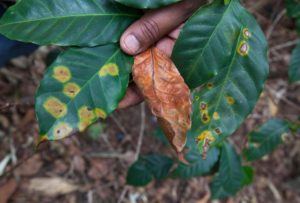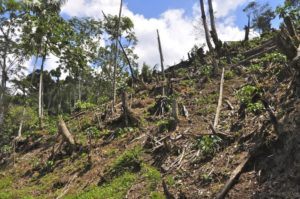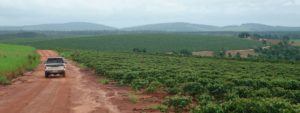Climate Change is Mugging Your Coffee

How Starbucks is striving to save coffee by whatever beans necessary.
Espresso. Macchiato. Frappuccino®. To many of us, these words elicit a great degree of joy. Now imagine a world where the daily grind is absent its greatest perk: your morning Starbucks. Sound unfathomable? Unfortunately, climate studies show that coffee as we know it may soon be a luxury of the past.
The grimmest reports state that Coffea arabica and Coffea robusta, the only two commercially relevant species of coffee, could be extinct by 2080 [1], [2]. However, what is far more likely is a constricted supply chain of quality beans. As demand continues to outpace production, prices will skyrocket and quality will plummet [3], [4]. Let’s dive deeper into the causes of this trend, and then touch on what Starbucks is doing about it.
To start our analysis, it’s important to understand where coffee grows. The Coffee Bean Belt is a strip of land from the Tropics of Cancer and Capricorn. Within this belt, Arabica grows best in tropical highlands with a temperature range of 18-21°C. Conversely, Robusta thrives in lowlands with higher temperatures. Arabica is the premium variety and currently accounts for 60% of global production [5]. As temperatures rise, farmers must seek higher ground and lower temperatures, thereby increasing costs. If no higher ground exists, then the only option is switching from Arabica to Robusta, which is a lower grade product largely reserved for instant and discount coffees [6]. Either way, both farmers and consumers are negatively impacted by increasing temperatures.
In many cases, loss of terrain is a smaller concern to an increasing prevalence of pests and diseases. The coffee berry borer is an insect that grazes primarily on coffee fruit. Rising temperatures have expanded the domain of this pest to areas where it previously could not survive [7]. Likewise, coffee rust is of much greater concern to farmers today than in years previous. Coffee rust is a fungal disease that devastated the Sri Lankan coffee industry in the 19th century [8]. Since coffee trees take three years to mature, farmers rarely have the capital resources to replant their crop once the disease takes root. Coffee rust is now a concern in most of the Bean Belt.

Fortunately for consumers, Starbucks has taken note of these trends and is well on the way to finding solutions. In 2013, Starbucks bought its first coffee farm: Hacienda Alsacia in Costa Rica. The intent is to develop tasty Arabica beans that are resistant to coffee rust and pests [9]. Unlike other major commodity crops like corn and soybeans, coffee is grown by small farmers that do not have the resources to pay for optimized growing systems, R&D, and the latest seed technology [10]. Coffee is also cursed with an usually shallow gene pool since Arabica trees self-pollinate [11]. As new seeds are developed at Alsacia, Starbucks is distributing them for free throughout the supply chain [12].
Another initiative that precedes Alsacia is Starbucks’s commitment to making coffee the first sustainable agricultural product [13]. Through a variety of initiatives, the company has donated over $100 million to coffee communities across the globe to improve growing practices and help farmers impacted by climate change to recover their livelihoods. They recently partnered with Texas A&M University-based World Coffee Research to aid farmers in Central America recovering from a leaf rust outbreak that decimated crops [14].
Despite strong efforts from Starbucks, more can be done to combat climate change in the medium and long term. For example, some farmers are turning away from shade grown coffee despite its universal reputation as the superior product. Shade grown coffee tastes better, requires little fertilizer, and less pesticides [15]. The tradeoff is yield: it is impossible to plant and harvest as many crops as you could in an open field. Unfortunately, as temperatures increase across the Bean Belt, many farmers desperate for profits have turned to deforestation to increase yields in the short term. They are able to turn a quick profit on the lumber and then grow more crops [16]. This shortsighted strategy is going to have cascading effects on coffee quality and in turn the livelihood of these farmers.

Climate change will also impact the role of pollinators such as bees in coffee production. Pollinators are currently responsible for 20-25% of coffee production through increased fruit size and uniformity. As ecosystems are impacted or destroyed by climate change, projections show that habitats of pollinators will overlap less and less with the remaining coffee farms [17]. Taking actions with local governments to protect forests and improving shade grown coffee practices will help to mitigate the impacts of this threat.
At the current rate, coffee production will need to triple by 2050 to meet increased demand, doubling the current area of production [18]. As yields continue to decrease, how can Starbucks best position itself for long term success?
(Word Count: 800)
References:
[1] Emma Mills, “’Coffee could be extinct by 2080′: why climate change may eradicate your daily latte,” The Telegraph, September 1, 2016, http://www.telegraph.co.uk/food-and-drink/news/coffee-will-be-extinct-by-2080-climate-change-could-spell-an-end/, accessed November 2017.
[2] Jonah Engel Bromwich, “Climate change threatens world’s coffee supply, report says,” The New York Times, September 22, 2016, https://www.nytimes.com/2016/09/23/science/climate-change-threatens-worlds-coffee-supply-report-says.html, accessed November 2017.
[3] Sara Chodosh, “Climate change will make your coffee cost more and taste worse,” Popular Science, June 21, 2017, https://www.popsci.com/climate-change-will-make-your-coffee-cost-more-and-taste-worse, accessed November 2017.
[4] Nassos Stylianou, “Coffee under threat: Will it taste worse as the planet warms?” BBC News, June 19, 2017, http://www.bbc.co.uk/news/resources/idt-fa38cb91-bdc0-4229-8cae-1d5c3b447337, accessed November 2017.
[5] Alessandro Craparo, “Coffee snobs: This brew may get pricey, thanks to climate change,” Fortune, June 2, 2015, http://fortune.com/2015/06/02/coffee-snobs-this-brew-will-get-pricier-thanks-to-climate-change/, accessed November 2017.
[6] Charlie Mitchell, “The coffee bean belt: Climate change map,” Financial Times, September 24, 2017, https://www.ft.com/content/a3b5748e-51c8-11e7-a1f2-db19572361bb, accessed November 2017.
[7] “Coffee and climate: What’s brewing with climate change?” Union of Concerned Scientists, October 18, 2011, http://www.ucsusa.org/global_warming/science_and_impacts/impacts/impacts-of-climate-on-coffee.html#.WgvHS2hSxPZ, accessed November 2017.
[8] Gideon Long, “Colombia coffee farmers tackle many foes in fight to do it right,” Financial Times, September 24, 2017, https://www.ft.com/content/ed531f08-51c6-11e7-a1f2-db19572361bb, accessed November 2017.
[9] “For partners, from partners: The first crop of coffee from Starbucks Costa Rica farm,” Starbucks, October 15, 2014, https://news.starbucks.com/news/hacienda-alsacia-coffee, accessed November 2017.
[10] Caitlin Dewey, “The race to save coffee,” Washington Post, October 19, 2017, https://www.washingtonpost.com/graphics/2017/business/the-race-to-save-coffee/?utm_term=.b23d204bfdda, accessed November 2017.
[11] Jackson Landers, “With smart planning, coffee and bees can survive climate change,” Smithsonian, September 11, 2017, https://www.smithsonianmag.com/smithsonian-institution/tropical-bees-and-coffee-will-survive-climate-change-smart-planning-180964836/, accessed November 2017.
[12] “The coffee farm dedicated to ensuring the future of coffee,” Starbucks, April 25, 2017, https://1912pike.com/starbucks-hacienda-alsacia/, accessed November 2017.
[13] “Ethical sourcing: Coffee,” Starbucks, https://www.starbucks.com/responsibility/sourcing/coffee, accessed November 2017.
[14] Nick Brown, “Starbucks grants $400,000 to World Coffee Research to assist Guatemalan farmers,” Daily Coffee News, April 8, 2015, https://dailycoffeenews.com/2015/04/08/starbucks-grants-400000-to-world-coffee-research-to-assist-guatemalan-farmers/, accessed November 2017.
[15] Meghan Bartels, “Climate change effects could mean the end of coffee beans,” Newsweek, September 14, 2017, http://www.newsweek.com/climate-change-effects-could-end-coffee-beans-bees-pollinators-664836, accessed November 2017.
[16] Nick Brown, “Climate change could make coffee a major driver of tropical deforestation,” Daily Coffee News, April 19, 2016, https://dailycoffeenews.com/2016/04/19/climate-change-could-make-coffee-a-major-driver-of-tropical-deforestation/, accessed November 2017.
[17] Merrit Kennedy, “Coffee, bees and climate change are linked in ways you may not have expected,” NPR, September 11, 2017, https://www.npr.org/sections/thetwo-way/2017/09/11/550169720/coffee-bees-and-climate-change-are-linked-in-ways-you-may-not-have-expected, accessed November 2017.
[18] “Future demand and climate change could make coffee a driver of deforestation,” Conservation International, April 4, 2016, https://www.conservation.org/NewsRoom/pressreleases/Pages/Future-Demand-and-Climate-Change-Could-Make-Coffee-a-Driver-of-Deforestation-.aspx, accessed November 2017.





It’s hard to argue that Starbucks hasn’t meaningfully contributed to the 2x coffee consumption increase over the last 30 years – to deny this would be to deny their success. I find their recent adoption of a green, pro-sustainability message to be a barely-disguised attempt to set up a barrier to entry for competitors. How can a company, with extremely lax procurement policies be seen as a beacon of the green movement in the industry. For example, in 2016, they promised to “pursue” zero net deforestation across their supply chain. This only means that they will continue to partner who clears forests, and offset the guilt by planting trees elsewhere (not even coffee). As someone who has worked on high-quality Arabica plantations in Jamaica and also seen the standards of Starbucks-driven Robusta plantations in Brazil.. they are tremendously far from “green”. We should demand that the driver of coffee consumption of the last several decades adopt true standards.
I wonder if there is any waste/inefficiency in the global coffee supply chain that Starbucks can also tackle to address sustainability issue. For example, for fresh produce supply chain, much produce (up to 50% for certain varieties) is wasted during transport because of climate controlling issues or produce not picked at the right time. I think there’s probably less of a degradation issue with coffee but it could be interesting to look into if there’s any efficiency gain in processing coffee closer to the source. There’s also potential savings in reducing the amount of coffee beans used in making coffee by optimizing the brewing process and developing better brewing technology.
Chi brings up an interesting point. As Starbucks grows internationally, can they maintain their image as a global brand while only using beans grown within that region in order to reduce emissions from transportation? The downside is perhaps coffee consumption in a country like the US far exceeds local or regional coffee bean supply, so this policy would actually further deplete plantations while perhaps “starving” other suppliers of meaningful business.
On another note, I wonder if there’s more Starbucks can do to incentive farmers to make the sometimes risky and/or expensive tradeoffs needed to be more environmentally friendly. Right now, it sounds like they are donating money to communities that are affected by unexpected adverse situations like leaf rust outbreak. But, what if Starbucks guaranteed farmers an above-market rate price for beans to compensate for lower yields. Is this a cost they can pass-through to consumers? Are there enough consumers that care deeply about climate change and would be willing to incur an additional cost on their daily cup of coffee? Perhaps there’s actually some positive PR from these types of actions that would counteract the increase in COGS.
Another option that would likely be very controversial is to vertically integrate and employ farmers directly. Something I saw in Uganda and Kenya (very limited exposure) was that middlemen who purchased beans from the small farmers, managed the processing and packaging, and then sold to larger companies or local retailers were the ones making the most money. It sounded like the small farmers were getting robbed because they had no bargaining power – they were small and ultimately needed to sell their beans. So while vertical integration would invite criticisms around a large company taking advantage of small farmers and reaping all the benefits, I wonder if in some places it’s a better alternative to the current marketplace and supply chain (would need really strong controls in place to avoid abuse of power).
Interesting read, I will finally have something to talk to the barista about when I’m getting an expresso. Regarding Starbucks response to these new threats, I wonder if they are genuinely focused on supporting coffee growers. I suspect that instead, their objective is mainly building their image as an eco-conscious company. It would be interesting to see if they would invest in more controversial solutions such as genetic engineering or increased pesticide and fertilizer use. I believe that they would dismiss these methods, even if proven to be more effective because they are more concerned with public perception then increasing coffee production.
A world without coffee is one I certainly wouldn’t want to live in. Although, let’s get comfortable with the fact that they will likely come from places less desirable than the “bean belt” like they have in the past. High up in the mountains in warm regions that are known for very warm days to contrast their very cold nights have typically been the best– this intense change in temperature is what makes our coffee so delicious. However, climate change does not make coffee disappear — the “okay” coffee supply probably increases and can be shifted to other places in the world. East African countries, southeast Asia and India have become popular places to replace the South and Central American countries supply. For certain though, the process of severe temperature change in the high altitude mountains around the bean belt disappearing certainly creates an issue for the best tasting coffee. Perhaps we can get ahead of this trend by pricing the “best of the best” up so that we get used to drinking the “good enough stuff” (as we surely will have to in the future).
Interesting! If I were managing Starbucks, I would worry about two main aspects: one is how to set new standards in the supply chain, the other one is reducing emissions.
Donations to farmers are a weak solution to the supply chain problem. You could try to add incentives, but it is hard to convince farmers that are deeply risk averse. Furthermore, comparing this case with my article, Walmart provides technology and research resources for suppliers who are willing to embrace the challenge. With this being said, I think that the best way to solve the issue is to increase control by pursuing vertical integration. I agree with Justine that this creates a risk of controversy, but I think it will be easier for Starbucks to implement some of the practices they have been testing in Costa Rica, using its much bigger resources, in terms of money and access to technology.
The other challenge they are facing is reducing carbon emissions. In 2008, Starbucks set the ambitious goal to reduce emissions by 25%. The results were disappointing; the company initially reduced its emissions, but in 2012 emissions started to increase again. The company increased its emissions from 1 million metric ton to 1,258,092 tons between 2012 and 2014. It is relevant to acknowledge that one of the causes of this trend was a change in Starbuck’s strategy: the decision to add heated food to the menu. As a consequence, it needs more refrigeration and ovens, thus more energy. Starbucks reacted to critics saying that it is working on improving oven environmental efficiency, but the it is difficult to believe that they will be able to reach their goals.
This is assuming that Starburks’ priority is to solve the issue rather than building its own image, as Tom mentioned. I think every discussion about climate change should start making sure that the company is really trying to solve the problem, otherwise all conversations fall into rhetoric and become empty.
Besides improvements in the existing coffee chain (from seed development, farming techniques / growers communities, to waste/inefficiencies as pointed by Chi), an option for Starbucks to be best positioned for long-term success is to invest in substitutes to coffee.
With the idea of reinventing itself and leveraging its scale and brand power, Starbucks can influence customer behavior towards new types and formats of drinks, further expanding beyond coffee. As mentioned in our Marketing case (“Starbucks: Delivering Customer Service”), Howard Schultz, Starbucks founder, managed to transform a commodity into an upscale cultural phenomenon – and such influence should be used to shape future customer behavior.
Surprisingly, Starbucks’ mission does not include the word “coffee” (Check https://www.starbucks.com/about-us/company-information/mission-statement). With a mission “To inspire and nurture the human spirit – one person, one cup and one neighborhood at a time.”, there is space to explore drink alternatives (least creative examples are cocoa and tea blends) and reduce stress on the coffee chain. For several substitutes the challenges in large-scale and long-term sustainability could be similar to those of the coffee chain, still, there is value in diversifying risks inherent to a single crop and expanding customer base.
There are indeed risks in diverging from the heart of the company (its values are centered around partners, coffee and customers). Although I believe that coffee will continue to be the company’s core for several years, I also envision the scenario that coffee prices will reach a level in which average customers will feel forced to look for alternatives. With a fine balance not to cannibalize its current business, Starbucks could challenge its R&D / Marketing areas to come up with a product and a story to consumers that feel as functional & heart-warming as a good cup of coffee.